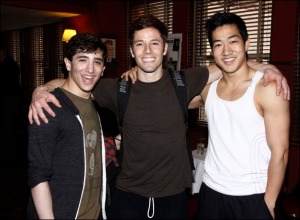By Melanie Brown, CTFD Client Outreach Coordinator
One of our annual outreach events at Career Transition For Dancers is the Broadway Dancer Between the Shows Get-Together at the famous Sardi’s Restaurant. Wednesday is a crazy day for Broadway performers; they play two shows, one at 2pm and one at 8pm, with just a couple of hours of downtime in between. At CTFD, we like to seize any and all opportunities to serve the dancers we love, and this event is only one of many.
The event, a standing springtime tradition for more than ten years, is a chance for Broadway dancers to get together, chat, network, and hear about the programs and services that Career Transition For Dancers offers. In the few hours between the last curtain of the first show and call for the next show, the dancers come to Sardi’s, learn about us, and enjoy a delicious buffet, open bar, and excellent company.

Photo by Joseph Marzullo/WENN
This year’s turnout was excellent—the event hummed with dancers from every show. From Jesus Christ Superstar, to How to Succeed in Business, to Mary Poppins, and beyond, the Eugenia Room was at capacity. We even had a few former So You Think You Can Dance contestants join us for the party! Alex Wong (Season 7), Jess Le Protto (Season 8), and Thayne Jasperson (Season 4) all represented Newsies at this year ’s event. It was exciting for CTFD, especially given our new partnership with Nigel Lythgoe and SYTYCD.
While the dancers ate, Anything Goes dancers Kiira Schmidt and Mark Ledbetter both gave wonderful testimonials about their experiences with our grants, scholarships, services, and CTFD’s NYC Career Counselor Lauren Gordon (who also served as emcee for the evening).

Our event is always hosted by a who’s-who of Broadway alumni, but this year’s hosts were truly the best of the best. Tony Award-winning choreographer and producer Jerry Mitchell kicked the evening off with his own transition story and an invitation to “come up and talk to me!” once the speakers were through. Three time Tony Award-winner and 2012 Tony nominated choreographer and director Kathleen Marshall, NBC’s hit Smash choreographer Josh Bergasse, Broadway’s hit choreographer of Jersey Boys and Memphis Sergio Trujillo, and former Broadway dancers Kirk Sprinkles, Krisha Marcano, and Charlotte D’Amboise all joined Jerry in his welcoming spirit, and the result was fantastic!
Dancers lined up to talk to all of our hosts about their experiences onstage, in transition, and in their new careers. The Sardi’s between shows get-together is always a special event for CTFD and the Broadway community, and this year was no different. Check out more of the great photos from the evening at playbill.com. A special thank you to the Schubert Organization for sponsoring this annual event.

